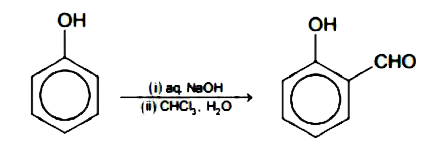
The electrophile involved in the above reaction is:
DichloroMethyl cation (C⊕HCI2)
Dichlorocarbene (:CCI2)
TrichloroMethyl anion (ΘCCI3)
Formy1 cation (⊕CHO)
The correct Answer is:B
The Riemer-Tiemann reaction is followed by dichlorocarbene mechansium.
Topper's Solved these Questions
- BOOK - A2ZCHAPTER - ALCOHOLS, PHENOLS AND ETHERSEXERCISE - Ethers34videos
ALCOHOLS, PHENOLS AND ETHERS
- BOOK - A2ZCHAPTER - ALCOHOLS, PHENOLS AND ETHERSEXERCISE - Section B - Assertion Reasoning20videos
ALCOHOLS, PHENOLS AND ETHERS
- BOOK - A2ZCHAPTER - ALCOHOLS, PHENOLS AND ETHERSEXERCISE - Chemical Properties Of Alcohols61videos
ALCOHOLS, PHENOLS AND ETHERS
- BOOK - A2ZCHAPTER - ALDEHYDES, KETONES AND CARBOXYLIC ACIDEXERCISE - Section D - Chapter End Test30videos
ALDEHYDES, KETONES AND CARBOXYLIC ACID
Similar Questions
Knowledge Check
- Question 1 - Select One
The electrophile involved in the given reaction is:
 ACCI2B.−CCI3C.+CHOD.+CHCI2
ACCI2B.−CCI3C.+CHOD.+CHCI2 - Question 2 - Select One
The electrophile involved in the following reaciton is
 Aformyl cation (+CHO)BDichlorocarbene (:CCl2)CDichloromethul cation (+CHCl2)DTrichloromethyl cation (:−CCl3)
Aformyl cation (+CHO)BDichlorocarbene (:CCl2)CDichloromethul cation (+CHCl2)DTrichloromethyl cation (:−CCl3) - Question 3 - Select One

What is the intermediate involved in the above reaction ?A:CH2BCCl2C⊕CH3D⊕CCl2
The electrophile involved in the nitration of benzene is
View Solution
Select the reactions involved in the reaction above reaction :View SolutionThe electrophile in nitration of benzene reaction is:
View SolutionThe electrophile involved in chlorination of benzene is
View SolutionReimer-Tiemann reaction introduces an aldehyde group on to the aromatic ring of phenol, ortho to the hydroxyl group. This reacrtion involves electrophilic aromatic subsititution. It is a general method for the synthesis of subsituted salicyladehydes as depiced below:

The electrophile in this reaction is:View Solution


